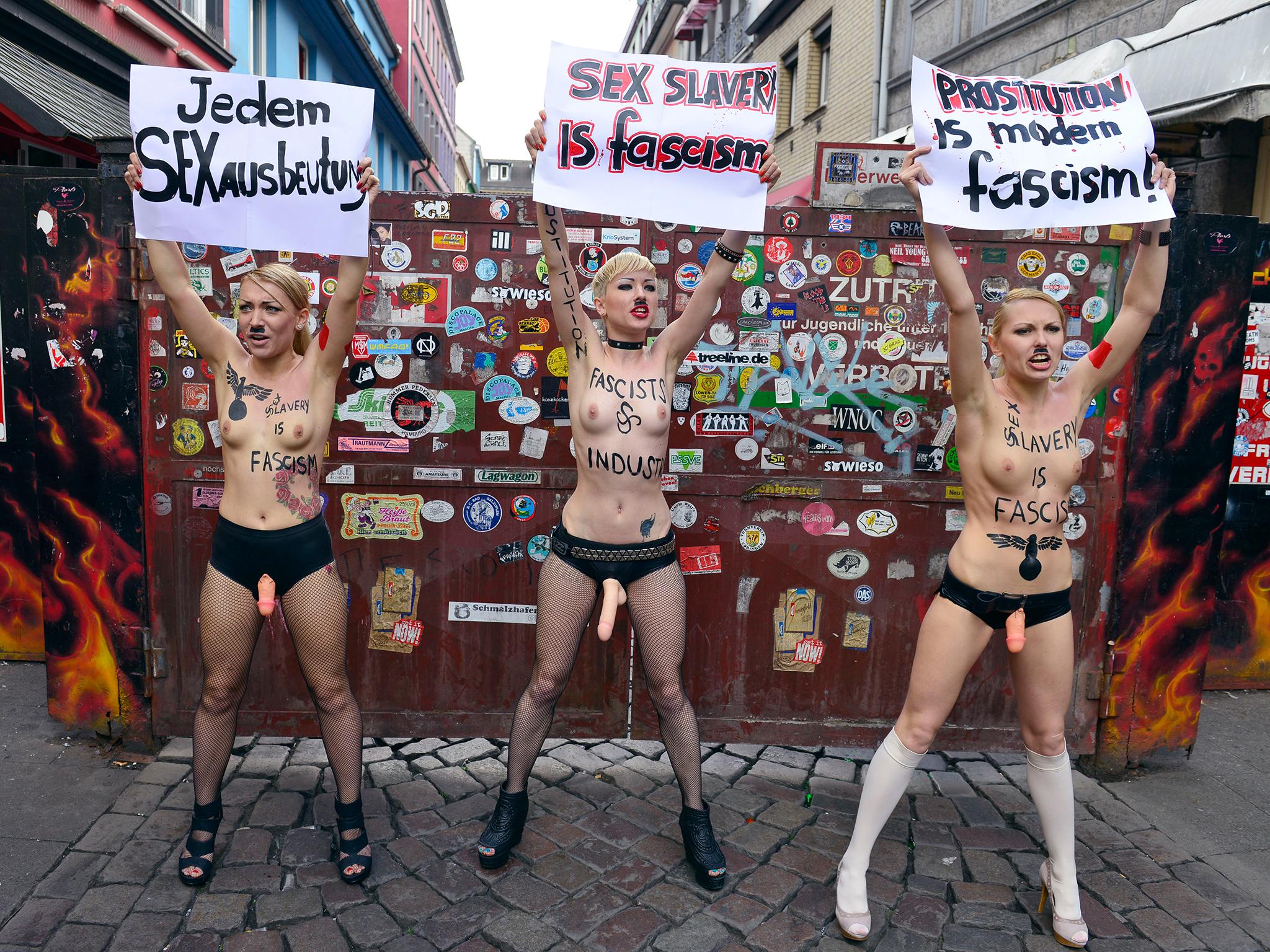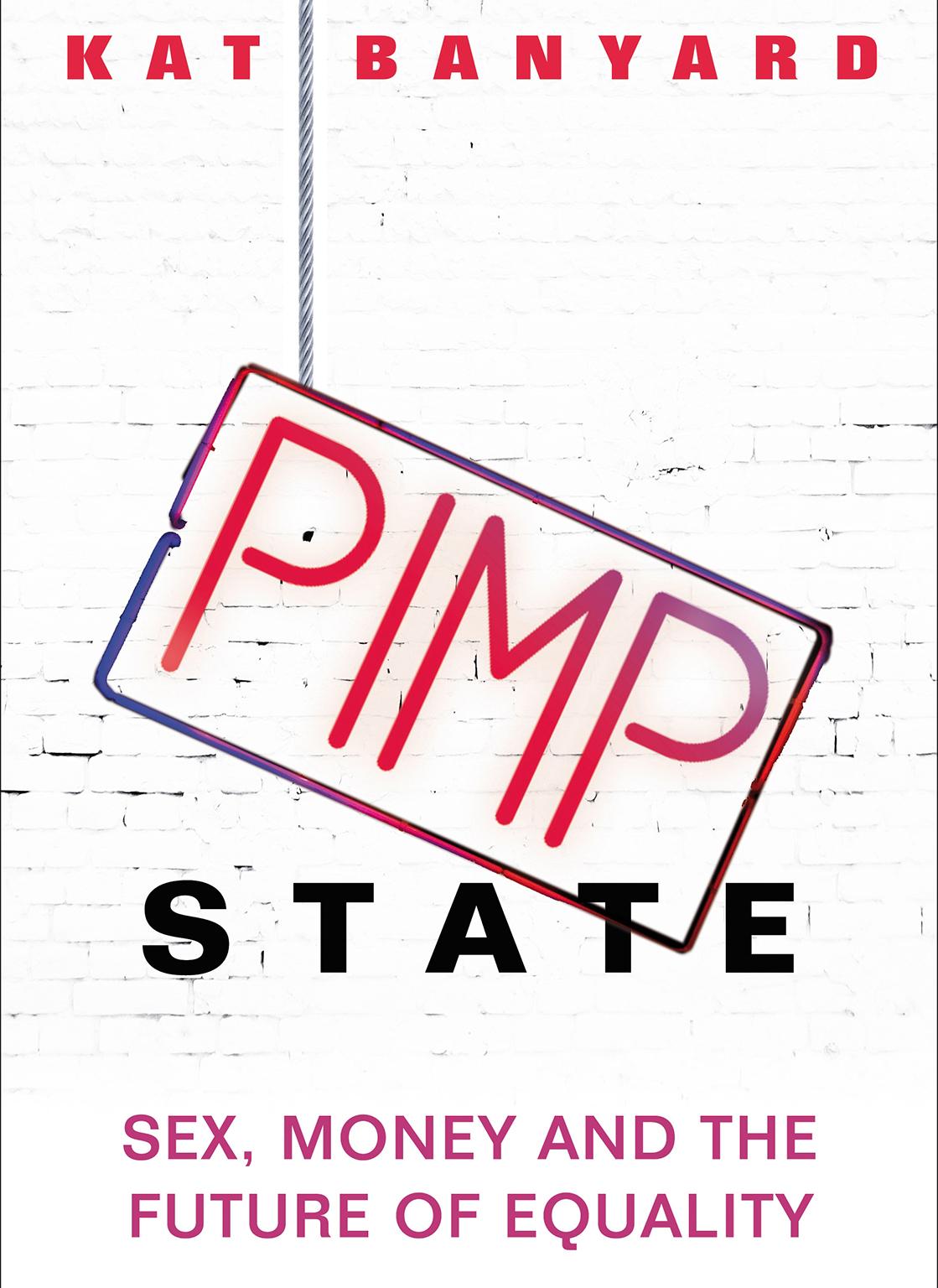We're living in a pimp state
In her controversial new book, Kat Banyard claims that the sex trade – increasingly tolerated and regulated by governments – is inherently sexist

Your support helps us to tell the story
From reproductive rights to climate change to Big Tech, The Independent is on the ground when the story is developing. Whether it's investigating the financials of Elon Musk's pro-Trump PAC or producing our latest documentary, 'The A Word', which shines a light on the American women fighting for reproductive rights, we know how important it is to parse out the facts from the messaging.
At such a critical moment in US history, we need reporters on the ground. Your donation allows us to keep sending journalists to speak to both sides of the story.
The Independent is trusted by Americans across the entire political spectrum. And unlike many other quality news outlets, we choose not to lock Americans out of our reporting and analysis with paywalls. We believe quality journalism should be available to everyone, paid for by those who can afford it.
Your support makes all the difference.“Would you mind stepping outside?”
Not wanting to draw more attention to myself, I did as the official whispering in my ear asked. I got up from my seat and tried to look surprised, though unconcerned, as I was escorted out of the conference room. Out in the corridor the event official turned to me. “I just want to make sure 'cause we’ve had some situations. Are you here with a company?”
The woman didn’t elaborate on what “situations” had occurred but I knew what she was referring to. Three days earlier, delegates arriving here at XBIZ EU, a pornography trade conference held in London, had received a rather unceremonious welcome from a group of feminist protestors. Now the mere presence of one youngish-looking woman on her own was apparently enough to make the organisers twitchy.
But why should a single woman stick out like a sore thumb at a porn industry meet-up? After all, the world’s most famous porn peddler, Hugh Hefner, has argued that “Playboy and the Playboy clubs were the end of sexism. Women were being held in bondage for hundreds of years, owned first by their fathers and then by their husbands. Playboy helped to change all that. That’s what the sexual revolution was all about.”
As the supposed lucky beneficiaries, shouldn’t women and girls have been queuing around the block to find out what new developments in the porn industry would help keep patriarchy at bay?

Hefner portrayed himself as a women’s rights pioneer, straight-faced, to a reporter quizzing him in 2011 about protests against his new Playboy Club in London. They had been organised by the pressure group Object and UK Feminista, an organisation I’d set up the previous year, precisely because the engine rooms of the real revolution Hef helped inspire – the global expansion of the sex trade – are not packed out by the grateful daughters of feminism.
They are filled with the people I sat among that day in 2013 when I attended the porn trade conference: businessmen. (As it transpired, I was allowed to return to the meeting room after I reassured the organisers I was there for research, rather than placard-waving purposes.)
The conference was hosted at the four-star Radisson Blu Edwardian Bloomsbury Street Hotel. This high-end setting was a testament to how far the porn trade has travelled. Once deemed the preserve of seedy backstreets, the pornography industry has bulldozed its way into the mainstream, and on to Wall Street. In 2011, US investment fund Colbeck Capital Management gave a $362m loan to a porn company. That company was Manwin (since renamed MindGeek), a sprawling multinational corporation with over 35 subsidiaries and which owns some of the most heavily visited porn websites in the world: Brazzers, Pornhub and YouPorn.
The man who built this porn empire was Fabian Thylmann, a computer programmer whose online ventures were generating millions of dollars while he was still in his twenties and saw him dubbed ‘the Mark Zuckerberg of porn’. Casting a wistful eye over his long career, 84-year- old Hefner reminisced in 2010: “The criticisms that troubled me the most came from the feminists, from liberals, at the very beginning. I was blindsided by them and didn’t know what they were talking about.”

But the Playboy founder was resolute as to who had come out on top. “I think my critics are dead wrong. It was clear to me then; it’s clearer to me today, because I think history has proven me right . . . I’ve won. We now live in a Playboy world.”
Hefner’s claim can’t easily be written off as mere delusion of grandeur. Pornography has never been more easily, cheaply or heavily consumed as it is today. You can buy Playboy magazine from high-street shops, go to a Playboy Club, visit Playboy Online, and watch Playboy TV on cable and satellite.
The websites owned by Manwin (now MindGeek) alone are reported to clock up around 16 billion visits each month, while over $1bn in transactions are processed each year by Ron Cadwell’s firm CCBill – the PayPal of porn and go-to online billing company for porn sites. The findings of a recent BBC survey, then, that a quarter of young people have watched pornography by the time they reach their teens, come as little surprise.
Pornography isn’t the only part of the sex trade to have experienced a boom over the past two decades. During this time, the number of women paid for sex in Germany’s prostitution trade is thought to have doubled, with the current figure pegged at 400,000. The proportion of men in the UK who have paid for sex almost doubled during the 1990s, from one in 20 to nearly one in ten, while UK lap-dancing clubs increased ten-fold between 1997 and 2011. One strip club chain, Spearmint Rhino, today racks up annual sales of nearly $200m, according to CEO John Gray.

As the sex trade has ballooned, inevitably its influence on popular culture has too. Sometimes that influence isn’t just a knowing nod from advertisers, or a borrowed motif in a music video, it’s a direct fusion of the two worlds. In 2005, HBO launched Cathouse: The Series, which documented daily life at the Moonlite BunnyRanch, a legal brothel in Nevada. Its owner, Dennis Hof, explained the benefits of this exposure to an interviewer: “Our clients, our friends, can watch our TV show, see us at an award show, and say, ‘Wow, that Airforce Amy is looking really good. I’m gonna go to the BunnyRanch.’ That’s what the success of our show is . . . that finally these are goals that are attainable for the average man . . . I’ve taken prostitution from guilt and shame to glamour and fame.”
Pointing out that the sex trade generates substantial profits or that it has secured a firm foothold in the cultural mainstream is not a source of great controversy. How societies should respond is. Indeed, how the state should deal with this trade is shaping up to be one of the big debates of our time.
Should it be legal to pay for sex? What’s the best way to promote the safety of women involved? How does online porn impact on boys’ attitudes towards women and sex? Is this an industry that is irredeemably sexist or something we should accommodate? In essence, are feminism and the sex trade on a collision course? These are questions that go to the very heart of society’s notions of sexual consent, violence and equality.
In recent years a consensus has begun to form around the idea that the sex trade and sex equality can in fact be comfortable bedfellows. Few would deny that the sex trade currently has a sexist side. But then, the argument follows, don’t all industries? The proposition that the two are compatible allows room for multiple interpretations: at euphoric best, the sex trade represents the promised land of feminism (see Hefner’s previous ‘end of sexism’ proclamation).
At worst, its present outputs merely reflect misogynistic attitudes in wider society. Somewhere in the middle, the trade is afforded a more mundane profile: that of ordinary work. Yet however sexist it is currently considered to be, what these interpretations share is the underlying presumption that the sex trade is compatible with feminism; that we needn’t work to end it; that it can be reformed.
The claim that building a feminist future does not necessitate the abolition of the sex trade is not some esoteric, ivory tower hypothesis. It’s a contention that today underpins a global bid for governments to accept, regulate and accommodate the trade.
Well, I want to challenge that bid. I want to show that it is only possible to maintain that the sex trade is compatible with equality between women and men through the creation and retelling of toxic myths: the myth that men paying women to perform sex acts on them is a harmless consumer transaction, on a par with him paying her to serve a cappuccino, dry clean his clothes, or perform any number of other service jobs.

The myth that pornography is mere fantasy, not “real life”, and that all we have to do is teach young people how to differentiate between the two. The myth that the sex trade can be made safe, and that the route to get there is by making paying for sex, pimping and brothel-keeping legal. And the myth that any sexism in the sex trade is merely a problem with the message (directors instructing male porn performers to use misogynistic language, say), not the medium itself (sexual consent that was “purchased”, in a brothel or on a porn set).
These myths are being used to create a culture and set of laws that encourage and facilitate men’s paid sexual access to women’s bodies: what I call a pimp state. It is being pursued most explicitly and literally in the call for governments to take a direct financial cut from the transaction – by licensing brothels, imposing rules on the people inside, and taxing them.
In 2004 MTV aired the first series of Pimp My Ride, a show which revolved around a run-down car being done-up and customised: “pimped”. Appropriately enough, the trade from which that term was borrowed has been given its own makeover, refashioned as a friend to feminism, or at least a benign associate. And for good reason. Because the reality behind these myths is far less convenient for the trade’s “customers” and third-party profiteers, like those attending the XBIZ EU conference.
The demand that drives the sex trade is both a cause and a consequence of inequality between women and men, not an inevitable fact of life. Regardless of the varying ways it is marketed, the sex trade boils down to a very simple product concept: an individual – usually a man – can pay to have a sexual interaction with someone – usually a woman – who doesn’t freely want to have it with him, and there are a bunch of reasons why she may have agreed to it.
For Mia de Faoite, whom I met during the course of my research, it was a drug addiction that first led her on to the streets of Dublin to spend six years being paid by men for sex. For Crystal, who spent over five years as an escort and in brothels, it was a violent boyfriend who first started pimping her. Addiction, pressure from a pimp, an overwhelming sense that there is no other option; there are a multitude of factors that may explain why she’s there.
But not one of them absolves the actions of the buyer: in the sex trade, the fact that the sexual interaction is not taking place because of mutual desire for emotional or sexual satisfaction is explicit and fundamental to the act – otherwise he wouldn’t have to pay her to be there. The sex trade manufactures consent; the result is commercial sexual exploitation on an industrial scale.
So it is understandable why third parties who enjoy the profits and “consumers” who enjoy the privilege would find common cause in masking this reality with myths. The narrative they peddle has acquired mainstream credibility and little resistance, in part because of a fear and smear campaign that frequently goes hand in hand with it. Those who dare to question the compatibility of the sex trade and sex equality are commonly derided as conservative, anti-sex ideologues.

The result is we are spectacularly failing as a society to confront the full reality of sexism at the core of the sex trade. And we will have to confront that reality if we are even remotely serious about wanting equality between women and men. That also means not ducking the fact that in this trade it is overwhelmingly heterosexual men who are the consumers and women who constitute the product.
As sex trade scholar Professor Karen Boyle points out, “the success of the porn industry largely depends upon the willingness of heterosexual men to buy its products, to enter into a contract which provides them with (vicarious) use of a female body for their arousal or amusement.” Same goes for stripping and prostitution, except there the use isn’t vicarious. It is an overwhelmingly and inescapably gendered phenomenon.
That is the reality.
“If you don’t like it, don’t buy it” doesn’t wash when it comes to the sex trade. Inequality between women and men is needed for patriarchal power plants like Dennis Hof ’s brothels to operate. It is also an inevitable by-product of that operation. “We change people’s ideas a day at a time . . . one person at a time. We win them over,” Hof has claimed. He is confident of his power to shape attitudes beyond the high white fence surrounding the Moonlite BunnyRanch, which, given the brothel’s media exposure, isn’t without grounds.
As someone whose exploits rely on the state to sanction them, the wider community to tolerate them, and the desire of some men to pay for them, Hof understands better than many that his industry does not operate in a social vacuum. The PR pursuits, daily operations and underlying logic of the sex trade communicate very public, and very powerful, messages.
In turn, society’s collective response to the trade is a didactic display in itself. Right now we live in a world in which it is estimated that one in five women will be raped or subjected to an attempted rape during their lifetime. A survey of young people in England found that over four in ten girls aged 13 to 17 had been coerced into sex acts.
For too many men and boys, the question of whether a woman or girl shares his desire for a sexual interaction is either irrelevant, or that mutuality unwanted. The global sex trade is built on the assertion that it is irrelevant whether the desire to have sex is mutual, as long as he pays, and she feels sufficiently compelled to accept the money. The money isn’t coincidence; it’s coercion. How we respond to the core message of the sex trade speaks volumes about how seriously society takes violence against all women.
Be in no doubt about the scale of what’s at stake. At a period in history when most (though certainly not all) countries are adding laws to the statute books that at least formally assert gender equality, the sex trade is making a concerted bid for states to re-inscribe the sexual subjection of women, albeit somewhat more between the lines this time.
Because responding to the present demand for the sex trade by boosting, not blocking, the ability of pimps and pornographers to pump out profits from it re-institutionalises male sexual entitlement – that antediluvian cultural current that says men have a right to access women’s bodies, regardless of whether the desire is mutual.
It is the collective arms of the state responding to violence against women not by dampening down the conditions for it, but by putting a rocket up it – by helping to attach a profit motive.
In her 1949 landmark work, The Second Sex, Simone de Beauvoir wrote: “What peculiarly signalises the situation of woman is that she – a free and autonomous being like all human creatures – nevertheless finds herself living in a world where men compel her to assume the status of the Other. They propose to stabilise her as an object.” The sexual objectification of women embodied and encouraged by the sex trade has become a central social force serving to ‘stabilise her as an object’, supercharged by the pursuit of profit.
The industry entails the direct sexual abuse of some women, while simultaneously powering a toxic culture of objectification that affects all women. In the story of the status of woman, the sex trade is no side-show. A pimp state – a society where commercial sexual exploitation is promoted, not prevented – is not one where women and men can live as equals.
It is a state that we can – and must – change.
‘The Pimp State’ by Kat Banyard (Faber, £12.99) is out now

Join our commenting forum
Join thought-provoking conversations, follow other Independent readers and see their replies
Comments